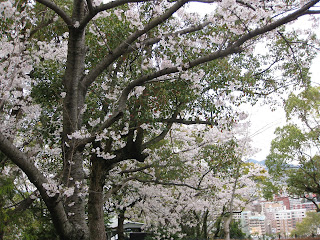

We spent the afternoon exploring the Osaka Castle, it is beautiful with all the cherry blossoms in full bloom.
The construction of Osaka Castle (Osakajo) started in 1583 on the former site of the Ishiyama Honganji Temple, which had been destroyed by Oda Nobunaga thirteen years earlier. Toyotomi Hideyoshi intended the castle to become the center of a new, unified Japan under Toyotomi rule. It was the largest castle at the time.
However, a few years after Hideyoshi's death, Tokugawa troops attacked and destroyed the castle and terminated the Toyotomi lineage in 1615. Osaka Castle was rebuilt by Tokugawa Hidetada in the 1620s, but its main castle tower was struck by lightening in 1665 and burnt down.

However, a few years after Hideyoshi's death, Tokugawa troops attacked and destroyed the castle and terminated the Toyotomi lineage in 1615. Osaka Castle was rebuilt by Tokugawa Hidetada in the 1620s, but its main castle tower was struck by lightening in 1665 and burnt down.



It was not until 1931 that the present ferro-concrete reconstruction of the castle tower was built. During the war it miraculously survived the city wide air raids. Major repair works gave the castle new glamour in 1997. The castle tower is now entirely modern on the inside and even features an elevator for easier accessibility. It houses an informative museum about the castle's history and Toyotomi Hideyoshi.




Late in the afternoon it was time to head out to the Sumo wrestling competition!!!! Oh, boy that was a fun experience such an interesting event we sure learned a lot about the rules and different ranks. My favorite thing was watching the people and all the advertising and fun signs. We also enjoyed all the delicious snacks.




After 2 hours of Sumo it was time to explore the night life of Osaka and also grab dinner at a Ramen noodle stand…….I would fly to Japan just to have those noodles again……..SO, SO GOOOOOOOOOOOOODDDDDDDD…..
Ramen noodles are very popular noodle dishes in Japan. Chukamen noodles which are made from wheat flour are boiled and put in various flavored soup. Although ramen originated in China, there are many regional sociality ramen available in Japan, and ramen shops are located all over Japan.
Ramen is quite simply Japan's premiere fast food. Ramen is something of an obsession in Japan. Yearly guides to the best ramen-ya are published in all of Japan’s major regions. Famous ramen-ya are promoted in tourist brochures right next to cultural and historic landmarks. Outside these local landmarks, crowds gather at lunch and dinnertime, willing to line up and wait regardless of the weather, sometimes for as long as an hour. Ramen stadiums, featuring five to ten ramen-ya from all over the country, are a common feature on the upper floors of department stores.
Many ramen-ya have a ticket vending machine. To order, buy a ticket, and then hand it to your server once your Ramen is ready he will hand it to you. The buttons are always in Japanese. This particular ramen place people just stand up and eat next to the counter. I tell you the food was so good who needs a chair?????
Ramen noodles are very popular noodle dishes in Japan. Chukamen noodles which are made from wheat flour are boiled and put in various flavored soup. Although ramen originated in China, there are many regional sociality ramen available in Japan, and ramen shops are located all over Japan.
Ramen is quite simply Japan's premiere fast food. Ramen is something of an obsession in Japan. Yearly guides to the best ramen-ya are published in all of Japan’s major regions. Famous ramen-ya are promoted in tourist brochures right next to cultural and historic landmarks. Outside these local landmarks, crowds gather at lunch and dinnertime, willing to line up and wait regardless of the weather, sometimes for as long as an hour. Ramen stadiums, featuring five to ten ramen-ya from all over the country, are a common feature on the upper floors of department stores.
Many ramen-ya have a ticket vending machine. To order, buy a ticket, and then hand it to your server once your Ramen is ready he will hand it to you. The buttons are always in Japanese. This particular ramen place people just stand up and eat next to the counter. I tell you the food was so good who needs a chair?????















































